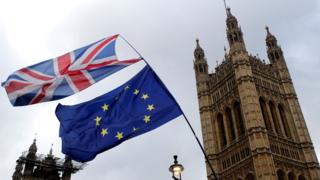 Image copyright
Image copyright
Reuters
We’ve had a Brexit Withdrawal Bill. We’ve got a Brexit withdrawal agreement.
Now it’s time for the Withdrawal Agreement Bill (WAB).
Its purpose? To turn the withdrawal agreement, which is a draft international treaty, into UK law and to give the government permission to ratify it.
The terms on which the UK will leave the EU have now been agreed between Boris Johnson’s government and the governments of the other 27 member states.
Theresa May’s government got to the same stage, but failed to win approval in Parliament for its negotiated settlement.
Mr Johnson hopes to go one better. His agreement needs to win the backing of MPs in a meaningful vote and then be turned into legislation.
Image copyright
AFP
He wants to get all that done by 31 October, which is a tough ask, to say the least.
Bills to implement major European treaties usually take several weeks to get through Parliament, and sometimes considerably longer.
If the government had a solid majority in the House of Commons, it could push the bill through pretty quickly. But it doesn’t, and its opponents will insist on more time to scrutinise the legislation properly.
It is, they argue, one of the most important pieces of legislation in decades, and MPs need to be sure they know exactly what it says and does.
There will also be opportunities for the legislation to be amended. It’s expected some MPs will try to add a provision for holding a confirmatory referendum on Brexit, for example, and for the UK to remain in a customs union with the EU.

So what will the WAB actually cover? Among other things:
- It will set out exactly how the UK will make “divorce bill” payments to the EU for years to come
- It will have to make sure that parts of EU law continue to apply in the UK for as long as a post-Brexit transition period lasts
- It will contain language on how the new protocol on Ireland – setting up a customs and regulatory border between Northern Ireland and Great Britain – will work in practice
- It will set out areas in which the European Court of Justice still plays a role in the UK, and make the withdrawal agreement in some respects “supreme” over other areas of UK law
In other words, it will get into some controversial topics.
That’s why the WAB is tricky for the government: sensitive issues which can be fudged a bit in political communications have to be set down in black and white – and in precise legal language – for all to see.
It’s another reason why time could be working against Boris Johnson and his “do or die” pledge to leave the EU at the end of October.
If the government cannot get the Withdrawal Agreement Bill through parliament in time, then the default position is currently that the UK would leave the EU without a deal on 31 October.
But under the terms of the Benn Act the Prime Minister has now sent a letter to European Council President Donald Tusk making a formal request for an extension to the Brexit process until 31 January 2020.
The EU will watch events in Westminster closely over the next few days, before deciding how to respond to the extension request.
What claims do you want BBC Reality Check to investigate? Get in touch
What is the Withdrawal Agreement Bill?}

